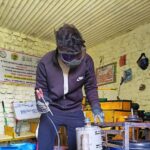Through her brand Balwaar, Kiran R Singh is reviving handloom-woven cotton blankets called khes and multi-coloured rugs called durries. She traces the journey of Balwaar, in her own words.
My husband was in the Navy and we moved around a bit. As a member of the Naval Wives Welfare Association, I taught women how to embroider, crochet and make laces so that they could make a living when they were back in their village.
In 1999, my husband and I moved back to Balwaar, his ancestral village.
Around 2004, when I first invited women to learn embroidery, only four very sceptical women showed up.
I taught them cross-stitch embroidery, emphasising on quality work. I gave them a reference sample, threads and a design drawn on paper so that they could take the work home.
Within a month, I had 40 local women at my door for work.
I also began experimenting with crochet items such as throws for Vanity Fair, an annual exhibition held in Chandigarh. The response was tremendous.
Now we are even weaving our own fabric.
In the meantime, my husband and I, with the support of friends and family started sponsoring the school fees of five girls. They were not allowed to study beyond class VIII as the school is in a neighbouring village. Each year we sponsor more girls.
This forged trust between the women and me. It was all very humbling. We would sit together and chat. Which was precisely what I wanted. I didn’t want a disconnect.
When I was looking for a handwoven khes once, I found only a woman weaver. It was a bit shocking since Punjab has a rich weaving culture.
With the help of my friends Sangeeta Sen and Priya Singh, I started a pilot project, weaving khes and durries with 18 local women. The idea was to create products that can be sold in the market.
The khes was woven in traditional Punjabi kumbal – a hand-thrown shuttle known as pit loom.
I wanted to make the production easier and faster, so I introduced the fly shuttle loom which basically makes the process faster, by getting a wider weave.
Now the women weave one khes daily, which would earlier take 5-6 days. The durries are woven on fixed-frame looms called atta. Twenty-two trained women work full-time and earn Rs 10,000 to 15,000.
The yarn for the khes is hand-spun on charkhas at Balwaar. Punjab has its very own iconography, especially for durries, and is inspired by the weaver’s surroundings. That’s how most of our durries are designed.
Sangeeta and I teach the women to create their own motifs and designs. Sangeeta has also been teaching them techniques to transfer their ideas onto the durries.
Currently, we are experimenting with natural dyes for a new collection in collaboration with the Khes project. I am proud to say that this little community of Balwaar has come a long way.
We frequently have students from schools around neighbouring cities, and design institutions to document the craft of weaving at Balwaar.
For me, Balwaar just happened. The flow of the universe has been benevolent.
Reporting by Navmalika Sidhu, a freelance content writer. She writes about sustainability in fashion, craft revival and consumer awareness in the fashion industry.
Photo courtesy: Navmalika Sidhu











